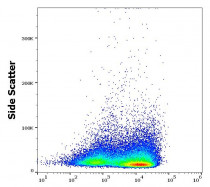ARG65386
anti-CD8b antibody [341]
anti-CD8b antibody [341] for Flow cytometry,Functional study,IHC-Frozen sections,Immunoprecipitation,Western blot and Rat
Immune System antibody
Overview
| Product Description | Mouse Monoclonal antibody [341] recognizes CD8b |
|---|---|
| Tested Reactivity | Rat |
| Tested Application | FACS, FuncSt, IHC-Fr, IP, WB |
| Specificity | The clone 341 (also known as 34.1) recognizes rat CD8b, the 32-34 kDa beta chain of the CD8 coreceptor, expressed on T cell subsets and some other cell types, such as macrophages. |
| Host | Mouse |
| Clonality | Monoclonal |
| Clone | 341 |
| Isotype | IgG1 |
| Target Name | CD8b |
| Immunogen | CD8 positive Wistar rat splenic T cell hybridomas |
| Conjugation | Un-conjugated |
| Alternate Names | LY3; CD8B1; CD antigen CD8b; LEU2; T-cell surface glycoprotein CD8 beta chain; P37; LYT3 |
Application Instructions
| Application Suggestion |
|
||||||||||||
|---|---|---|---|---|---|---|---|---|---|---|---|---|---|
| Application Note | Functional studies: Macrophage stimulation, in vitro blocking of allogenic responses. * The dilutions indicate recommended starting dilutions and the optimal dilutions or concentrations should be determined by the scientist. |
Properties
| Form | Liquid |
|---|---|
| Purification | Purified from cell culture supernatant by protein-A affinity chromatography. |
| Purity | > 95% (by SDS-PAGE) |
| Buffer | PBS (pH 7.4) and 15 mM Sodium azide |
| Preservative | 15 mM Sodium azide |
| Concentration | 1 mg/ml |
| Storage Instruction | For continuous use, store undiluted antibody at 2-8°C for up to a week. For long-term storage, aliquot and store at -20°C or below. Storage in frost free freezers is not recommended. Avoid repeated freeze/thaw cycles. Suggest spin the vial prior to opening. The antibody solution should be gently mixed before use. |
| Note | For laboratory research only, not for drug, diagnostic or other use. |
Bioinformation
| Database Links |
Swiss-port # P05541 Rat T-cell surface glycoprotein CD8 beta chain |
|---|---|
| Gene Symbol | Cd8b |
| Gene Full Name | CD8b molecule |
| Background | The CD8b (CD8 beta) subunit of CD8 T cell coreceptor is expressed in CD8 alpha/beta heterodimers on majority of MHC I-restricted conventional T cells and thymocytes and in CD8 alpha/alpha homodimers on subsets of memory T cells, intraepithelial lymphocytes, NK cells, macrophages, mast cells, and dendritic cells. Regulation of CD8 beta level on T cell surface seems to be an important mechanism to control their effector function. Assembly of CD8 alpha/beta but not alpha/alpha dimers is connected with formation or localization to the lipid rafts. Recruiting triggered TCR complexes to these membrane microdomains as well as affinity of TCR to MHC I is modulated by CD8, thereby affecting the functional diversity of the TCR signaling. |
| Function | Identifies cytotoxic/suppressor T-cells that interact with MHC class I bearing targets. CD8 is thought to play a role in the process of T-cell mediated killing. [UniProt] |
| Highlight | Related products: CD8 antibodies; CD8 ELISA Kits; CD8 Duos / Panels; Anti-Mouse IgG secondary antibodies; Related news: New antibody panels and duos for Tumor immune microenvironment Tumor-Infiltrating Lymphocytes (TILs) |
| Research Area | Immune System antibody |
| Calculated MW | 24 kDa |
| PTM | Phosphorylated as a consequence of T-cell activation. |
Images (2) Click the Picture to Zoom In
-
ARG65386 anti-CD8b antibody [341] FACS image
Flow Cytometry: Rat splenocytes suspension stained with ARG65386 anti-CD8b antibody [341] at 1 µg/ml dilution, followed by PE-conjugated Goat anti-Mouse antibody.
-
ARG65386 anti-CD8b antibody [341] FACS image
Flow Cytometry: Separation of Rat CD8b positive splenocytes (red-filled) from CD8b negative splenocytes (black-dashed). Rat splenocyte suspension stained with ARG65386 anti-CD8b antibody [341] at 1 µg/ml dilution, followed by PE-conjugated Goat anti-Mouse antibody.









